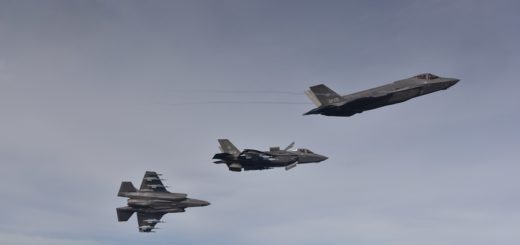Breaking News: Norway Strengthens F-35A Fighter Jet Strike Capabilities with Advanced JSM Joint Strike Missile Integration

{loadposition bannertop}
{loadposition sidebarpub}
On April 28, 2025, at Ørland Air Station, Norway will celebrate two landmark achievements in the modernization of its military forces. In addition to the official ceremony marking the delivery of all 52 F-35A Lightning II fighter jets ordered by Norway, an equally significant but perhaps even more transformative event will occur: the first delivery of the Joint Strike Missile (JSM) — an advanced air-launched cruise missile — to the Norwegian Armed Forces.Follow Army Recognition on Google News at this link
In 2021, the Norwegian Armed Forces completed the first test drop of the air-launched Joint Strike Missile (JSM) from an F-35A, marking a key milestone in operational integration. (Picture source: Norway MoD)
The arrival of the JSM (Joint Strike Missile) marks a substantial leap in Norway’s ability to project power and defend its interests autonomously. Developed by Norwegian Company Kongsberg Defence & Aerospace (KDA) in close collaboration with the Norwegian Defence Materiel Agency and the Norwegian Defence Research Institute (FFI), the JSM provides Norway with a cutting-edge, long-range precision strike capability. Brigadier Jarle Nergård, Head of Defence Materiel Air Capabilities, emphasized that the combination of the F-35 and JSM introduces a level of operational capability previously reserved for major powers. With this integration, Norway is now able to independently strike high-value targets such as enemy naval vessels, radars, and command centers over great distances, without relying on allied support.
Technically, the Joint Strike Missile is the only missile in its class designed to fit within the F-35A’s internal weapons bays, maintaining the aircraft’s stealth characteristics and operational range. This internal carriage is critical because it allows the F-35 to retain its low observable profile even while carrying offensive armaments, thereby maximizing its survivability in highly contested environments. However, the F-35A also has the ability to carry JSMs externally when low observability is not a primary concern. Specifically, the aircraft can be armed with two JSMs internally and four more externally on underwing pylons, enabling a total loadout of up to six JSM missiles per fighter. This flexibility provides mission planners with options depending on the threat environment and desired strike capacity.
The JSM itself features an advanced dual seeker system, combining an Imaging Infrared (IIR) seeker and a GPS/INS navigation suite, allowing it to autonomously detect, classify, and engage targets even in GPS-denied environments. It is equipped with two-way data-link communications, providing real-time updates and retargeting capability, enhancing flexibility during missions. One of the JSM’s critical strengths is its impressive operational range and flexible flight profiles, depending on the mission requirements. When launched in a high-high-low flight profile, the missile can achieve a range of approximately 555 km (345 miles; 300 nautical miles). In a high-low-low profile, the range exceeds 275 km (171 miles; 148 nautical miles), and even in a low-low-low penetration profile, it can strike targets up to 185 km (115 miles; 100 nautical miles) away. Its maximum speed is estimated at Mach 0.9 (around 310 m/s or 1,000 feet per second), making it a formidable tool for stand-off engagements. The JSM carries a 120-kg (260-pound) blast-fragmentation warhead, optimized to inflict severe damage on both naval and land-based targets.
The missile’s sophisticated flight behavior, including terrain-following capability at low altitude, minimizes the risk of detection and interception. Combined with its high agility and precision targeting, it can penetrate dense air defense networks to strike both stationary and moving targets, ensuring mission success under complex battlefield conditions.
The integration of the JSM cruise missile with the F-35 has been deeply optimized, with the missile’s design synchronized to exploit the fighter’s sensor fusion capabilities. The F-35’s radar, electro-optical targeting systems, and electronic warfare suite can all contribute to target acquisition and missile guidance, creating a potent networked strike system. Importantly, the JSM is one of the weapons systems slated to be fully integrated into the F-35A as part of the aircraft’s Block 4 upgrade — a major modernization program that will significantly expand the F-35’s sensor suite, weapons carriage, and software capabilities. This ensures that the JSM will be a core element of the F-35’s long-term operational portfolio, providing future-proof strike capabilities against evolving threats.
From a strategic perspective, the JSM-F-35 combination provides Norway with a truly sovereign strike capability that fundamentally changes its deterrence posture. Positioned in a geopolitically sensitive region bordering the Arctic and facing potential challenges in the North Atlantic and High North, Norway can now act independently to counter maritime and land-based threats without needing immediate assistance from NATO allies. This greatly strengthens both national defense and Norway’s contributions to collective security within NATO.
Moreover, the successful development of the JSM reflects the strength of Norway’s defense industrial base. Øyvind Kolset, head of the Missile and Space Division at Kongsberg Defence & Aerospace, underlined that the international recognition received by the JSM underscores Norway’s ability to deliver world-class defense technology through close cooperation between defense authorities and industry partners. The JSM project not only provides cutting-edge capability but also represents a technological achievement that elevates Norway’s position as a leader in modern missile technology.
With the delivery of the first JSM air-launched cruise missile and the full operational capability of its F-35A fleet, Norway today possesses a military edge that significantly increases its ability to safeguard national interests, deter aggression, and contribute meaningfully to regional and global stability.

{loadposition bannertop}
{loadposition sidebarpub}
On April 28, 2025, at Ørland Air Station, Norway will celebrate two landmark achievements in the modernization of its military forces. In addition to the official ceremony marking the delivery of all 52 F-35A Lightning II fighter jets ordered by Norway, an equally significant but perhaps even more transformative event will occur: the first delivery of the Joint Strike Missile (JSM) — an advanced air-launched cruise missile — to the Norwegian Armed Forces.
Follow Army Recognition on Google News at this link
In 2021, the Norwegian Armed Forces completed the first test drop of the air-launched Joint Strike Missile (JSM) from an F-35A, marking a key milestone in operational integration. (Picture source: Norway MoD)
The arrival of the JSM (Joint Strike Missile) marks a substantial leap in Norway’s ability to project power and defend its interests autonomously. Developed by Norwegian Company Kongsberg Defence & Aerospace (KDA) in close collaboration with the Norwegian Defence Materiel Agency and the Norwegian Defence Research Institute (FFI), the JSM provides Norway with a cutting-edge, long-range precision strike capability. Brigadier Jarle Nergård, Head of Defence Materiel Air Capabilities, emphasized that the combination of the F-35 and JSM introduces a level of operational capability previously reserved for major powers. With this integration, Norway is now able to independently strike high-value targets such as enemy naval vessels, radars, and command centers over great distances, without relying on allied support.
Technically, the Joint Strike Missile is the only missile in its class designed to fit within the F-35A’s internal weapons bays, maintaining the aircraft’s stealth characteristics and operational range. This internal carriage is critical because it allows the F-35 to retain its low observable profile even while carrying offensive armaments, thereby maximizing its survivability in highly contested environments. However, the F-35A also has the ability to carry JSMs externally when low observability is not a primary concern. Specifically, the aircraft can be armed with two JSMs internally and four more externally on underwing pylons, enabling a total loadout of up to six JSM missiles per fighter. This flexibility provides mission planners with options depending on the threat environment and desired strike capacity.
The JSM itself features an advanced dual seeker system, combining an Imaging Infrared (IIR) seeker and a GPS/INS navigation suite, allowing it to autonomously detect, classify, and engage targets even in GPS-denied environments. It is equipped with two-way data-link communications, providing real-time updates and retargeting capability, enhancing flexibility during missions. One of the JSM’s critical strengths is its impressive operational range and flexible flight profiles, depending on the mission requirements. When launched in a high-high-low flight profile, the missile can achieve a range of approximately 555 km (345 miles; 300 nautical miles). In a high-low-low profile, the range exceeds 275 km (171 miles; 148 nautical miles), and even in a low-low-low penetration profile, it can strike targets up to 185 km (115 miles; 100 nautical miles) away. Its maximum speed is estimated at Mach 0.9 (around 310 m/s or 1,000 feet per second), making it a formidable tool for stand-off engagements. The JSM carries a 120-kg (260-pound) blast-fragmentation warhead, optimized to inflict severe damage on both naval and land-based targets.
The missile’s sophisticated flight behavior, including terrain-following capability at low altitude, minimizes the risk of detection and interception. Combined with its high agility and precision targeting, it can penetrate dense air defense networks to strike both stationary and moving targets, ensuring mission success under complex battlefield conditions.
The integration of the JSM cruise missile with the F-35 has been deeply optimized, with the missile’s design synchronized to exploit the fighter’s sensor fusion capabilities. The F-35’s radar, electro-optical targeting systems, and electronic warfare suite can all contribute to target acquisition and missile guidance, creating a potent networked strike system. Importantly, the JSM is one of the weapons systems slated to be fully integrated into the F-35A as part of the aircraft’s Block 4 upgrade — a major modernization program that will significantly expand the F-35’s sensor suite, weapons carriage, and software capabilities. This ensures that the JSM will be a core element of the F-35’s long-term operational portfolio, providing future-proof strike capabilities against evolving threats.
From a strategic perspective, the JSM-F-35 combination provides Norway with a truly sovereign strike capability that fundamentally changes its deterrence posture. Positioned in a geopolitically sensitive region bordering the Arctic and facing potential challenges in the North Atlantic and High North, Norway can now act independently to counter maritime and land-based threats without needing immediate assistance from NATO allies. This greatly strengthens both national defense and Norway’s contributions to collective security within NATO.
Moreover, the successful development of the JSM reflects the strength of Norway’s defense industrial base. Øyvind Kolset, head of the Missile and Space Division at Kongsberg Defence & Aerospace, underlined that the international recognition received by the JSM underscores Norway’s ability to deliver world-class defense technology through close cooperation between defense authorities and industry partners. The JSM project not only provides cutting-edge capability but also represents a technological achievement that elevates Norway’s position as a leader in modern missile technology.
With the delivery of the first JSM air-launched cruise missile and the full operational capability of its F-35A fleet, Norway today possesses a military edge that significantly increases its ability to safeguard national interests, deter aggression, and contribute meaningfully to regional and global stability.






